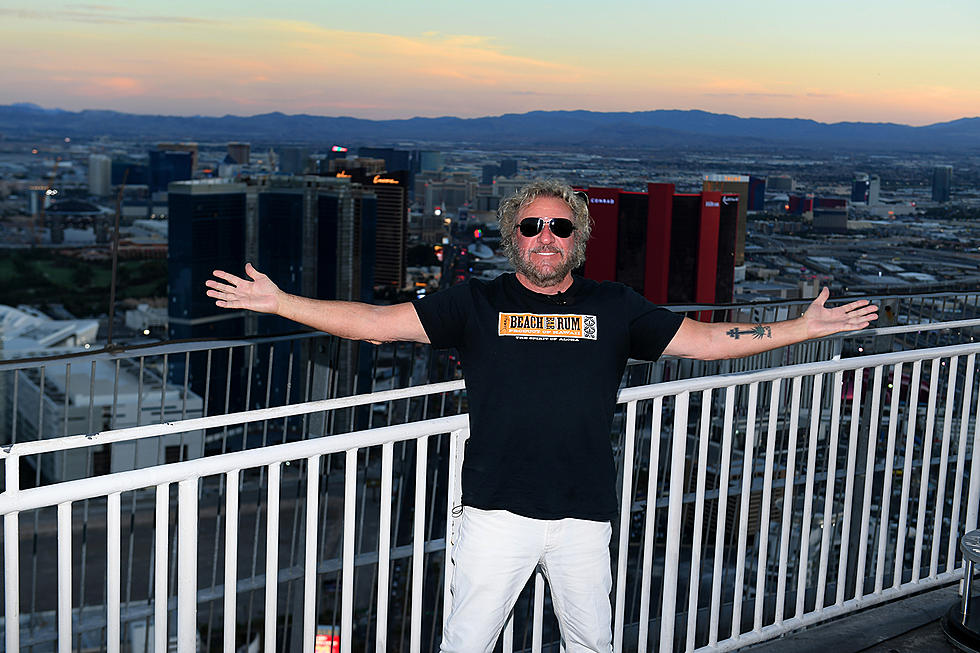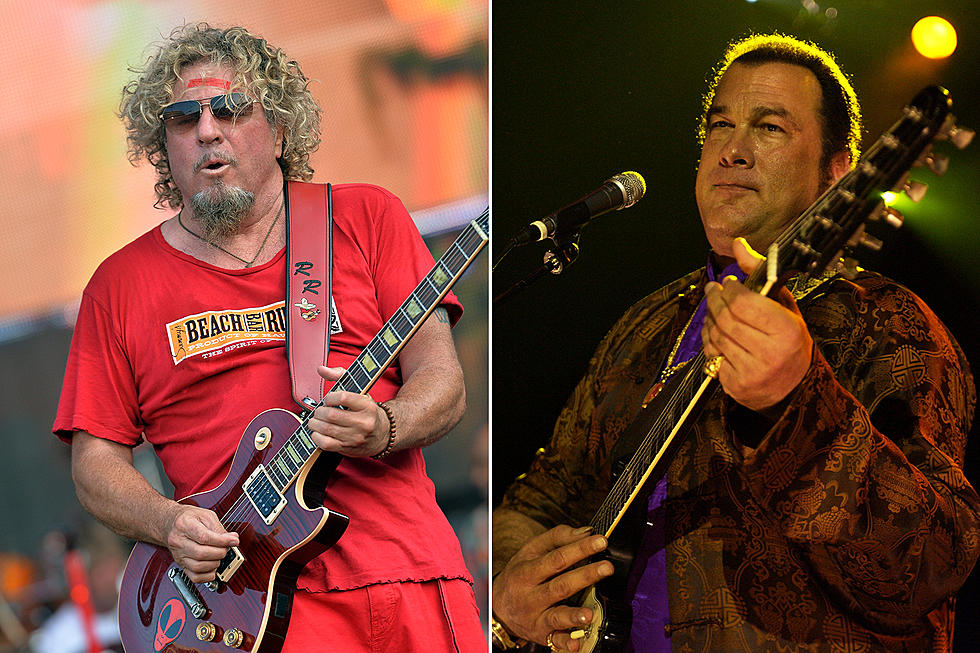Exclusive: Sammy Hagar Talks About ‘Paper Money,’ His Last Album With Montrose
Though the public at large had no way of knowing this just yet, when San Francisco hard rockers Montrose unveiled their sophomore album, ‘Paper Money,’ on Oct. 11, 1974, it was pretty much the work of a band that was well on its way to coming apart at the seams.
And to think that, just one year prior, things had looked so rosy for the exciting new group led by hot shot guitarist Ronnie Montrose who had diligently paid his dues as sideman to Van Morrison, Edgar Winter, and others before earning the chance to see his own name in lights … only to throw it all away.
That band -- and Montrose was a band, at first, no matter whose name showed on the album cover -- consisted of Ronnie’s former Van Morrison cohort, bassist Bill Church, drummer Denny Carmassi (whose future credits would include Heart, Joe Walsh, and countless other stars), and an unproven but innately talented and charismatic young singer named Sam Hagar.
Together, they packed their self-titled album -- produced by Ted Templeman -- with future classic-rock mainstays like ‘Rock Candy,’ ‘Bad Motor Scooter’ and ‘Space Station No. 5.’ Then they steadily built their fan following on the road before returning to the studio for what was expected to be an even stronger follow-up, ready to capitalize on its predecessor’s rock-solid foundation.
Instead, the songs written and recorded for ‘Paper Money’ would reflect the fractious state of band relations (bassist Church had already been replaced by Alan Fitzgerald, later the keyboardist with Night Ranger), caused in part by Ronnie’s desire to broaden Montrose’s sound beyond the debut’s dedicated hard rock focus, and in part by festering resentment with his chosen frontman’s burgeoning fame and confidence.
As Sammy Hagar recently related to Ultimate Classic Rock’s Matt Wardlaw, “The first album was a band and it was open to writing [but] the second record, Ronnie wouldn’t even listen to my songs. He was going to other people to write and I’m going, ‘Wait, I’ve got all of these songs.’ So we only co-wrote four songs on the album [and] he called one of them his own, which was ‘I Got the Fire.’ I wrote the lyrics and he said he forgot to put my name on the record. [Laughs.]"
Said Montrose/Hagar co-writes included ‘The Dreamer,’ a mega-riffed doom stomp, laden with a trippy mid-section and lyrics, ‘Spaceage Sacrifice,’ which in many ways felt like a pale reprise of the debut’s ‘Space Station No. 5,’ and the eye-opening title track, which locked into a hypnotic groove backed by unorthodox tribal percussion, capped by a stellar slide guitar solo from Montrose.
As for Ronnie Montrose’s solo credits, they included the engaging instrumental ‘Starliner,’ which convincingly imagined outer space adventures, and the surprisingly ambitious, heavily orchestrated ‘We’re Going Home.’ But it was a set of two cover tunes chosen to open ‘Paper Money’ that left most listeners scratching their heads.
The first was an obscure tune named ‘Underground’ by Chunky, Novi & Ernie that was given a soft rock arrangement ill-suited to Montrose’s collective talents. The second was far more impressive (though still shockingly mellow) reworking of the Rolling Stones’ 1967 ‘Between the Buttons’ track, ‘Connection,’ about which Hagar has some fond memories.
“I can remember singing that song the first time and Ted Templeman came running into the vocal booth [while] the glass door was shut," he told us. "He got so excited with my first take [that] he ran right into the f—kin’ glass and almost knocked himself out.” [Laughs]
As for the aforementioned ‘I Got the Fire’ (which would ironically go down as ‘Paper Money’s’ most enduring and best-known cut, later covered by Iron Maiden and others), its wholehearted throwback to the fierce hard rock of Montrose’s first album would later echo Ronnie’s comments in a 1997 interview for webzine, Anti-M, where he admitted that "it was the original dynamic of those four guys interacting together that [gave Montrose] power.”
Sammy Hagar, for his part, says he recalls little else about the album sessions. “Other than begging Ted Templeman to listen to my solo songs and [being told], ‘Ronnie’s the co-producer and he doesn’t want to hear this material.’ It broke my heart, man. I understand now what an ego is, but at that time, I didn’t.” he concluded, “You know, I hate to talk about Ronnie like that, but it wasn’t a happy ending and that record was the end of the road. It’s not a happy thing for me.”
With that in mind, all one can do is wish that Ronnie Montrose — who sadly passed away on March 3, 2012, at the age of 64 — were still with us so he could shed more light on the decisions that affected ‘Paper Money’s’ recording, and the fallout that ensued when Hagar was replaced by Bob James just as Montrose’s career profile was really starting to take off.
Instead, the group went from the slow-grinding platinum achievement of that first album (which amazingly never rose beyond No. 133 on the Billboard 200) to ‘Paper Money’s’ No. 65 U.S. showing to backtracking down the charts (No. 79) with their 1975 follow-up, ‘Warner Bros. Presents…Montrose!,’ and then missing them completely with 1976’s band-killing ‘Jump on It’ album.
Listen to Van Halen Cover 'Make It Last'
For Ronnie Montrose, a respectable, if hardly world-conquering, career would follow, while Sammy Hagar would trace his own long and eventful solo trail, steadily rising within the hard rock marketplace until achieving his well-deserved, star-level name recognition — all before replacing David Lee Roth in Van Halen, a move that, in retrospect, seems to have been destiny.
Over the years, numerous sources have suggested it was no mere coincidence that Van Halen finally landed on Warner Bros. under Templeman’s watch after being rejected by countless other labels, nor that they subsequently dropped the name Mammoth in exchange for the surname of their singularly talented lead guitarist (and his sibling drummer).
Then there are the separate occasions on which both Van Halen brothers and original bassist Michael Anthony claimed that Templeman himself floated Sammy Hagar’s name as a possible replacement for Roth before the recording of 1978’s ‘Van Halen,’ knowing full well by then that the boys held both Hagar-fronted Montrose LPs in the highest regard.
“You know, the first time I met Eddie," he continued. "[He] comes running into my dressing room and he’s shaking my hand and going, ‘Oh God, man, Montrose -- you know, we used to play ‘Make it Last’ and ‘Rock Candy.’ Man, I’m a huge fan.’ So they were definitely Montrose freaks. I’m sure that somebody in that band probably wouldn’t ever admit it, but you know, they used to sing Montrose songs.”
You Think You Know Sammy Hagar?
More From KLUB Tejano 106.9










